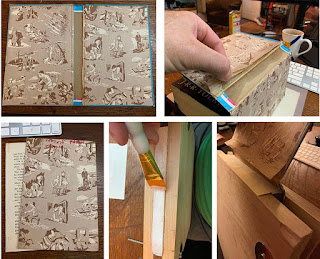For the last few years, I've been interested in the interior formatting for the Hardy Boys books. The Hardy Boys Online has extensive information about the various cover formats. It has long promised to update information on the interior art and formatting, but none has been posted yet.
This is part of what kicked off my fascination with scanning the interior drawings and trying to determine who drew them. Unfortunately, short of visiting archives at the New York Public Library or wherever the Stratemeyer Syndicate documents are housed, there is little more to do on that front. It is nice to have them all scanned and together in a document that allows comparison of styles.
There is still a lot that could be done on them, now that I think it over, but that involves trying to order them by probable creation date and looking at them with a more critical eye for the art itself. That's a bit beyond my ability to do without further research, but it is something to keep in mind, I suppose.
This year it dawned on me that the breeder set of original Hardy Boys books will enter the public domain in a year's time. That, coupled with recent success writing three similar style novels for NaNoWriMo, made me consider the formatting used for the books. I wanted to take the Hardy Boy fan fiction I wrote in 2019 and format it as if it were part of the original series.
This is something that appeals to me on many levels. I worked for 6.5 years at a copy shop as the desktop publishing manager, and have never lost my interest or curiosity about fonts and bookmaking. In the last 2-3 years I have been dabbling with learning bookbinding in order to repair some of my more damaged Hardy Boys titles.
So I took out my ruler and opened InDesign to set up an OT format for the text block of a Hardy Boys series title. The text block for these books was 5" wide by 7.375" high. They have a .875" inner and outer margin, with 1.125" to the top of the text and 1.25" for the bottom margin.
Sizing the font is a little tricky, given that these were originally letterset using slugs and I'm working with a computerized version of the font, but we can approximate fairly closely. I tried eyeing the font in the printed books to guess what they used, but its been too long since I did that for a living for me to be able to scan a font very well. I did a Google search on typefaces used by Grosset & Dunlap in the 1920s, and noticed Century Schoolbook as one of the fonts used. This immediately looked right to me, so I used it for my sample.
Originally, these books would have been imprinted from metal plates with lead slugs. The type would have been hand set. This means the spacing could be individually adjusted between letters and lines. The computer program does all of this adjustment automatically for both kerning and leading. I found that setting the font in 11 pt. Century Schoolbook with 12.1 pt. leading came closest to replicating the original.
There are other differences that are complicated by using a computer font. It is automatically designed into them to give extra spacing for sentence punctuation, so there is no need for old habits such as double spacing after a period. This can affect line breaks, making it difficult to exactly replicate the original formatting. I may do a sample page with the double spacing in place to check how closely that moves it toward the original, but I haven't done so yet.
I will follow this post up another day with more information, referencing the settings for running headers and footers, chapter start pages, and the preliminary text pages as well. I wish I had thought to include photos of sample pages to demonstrate what I'm doing and how similar the end result is, so I will also look to create some of those to include later. I may edit this post as well to include photos once I have them.









